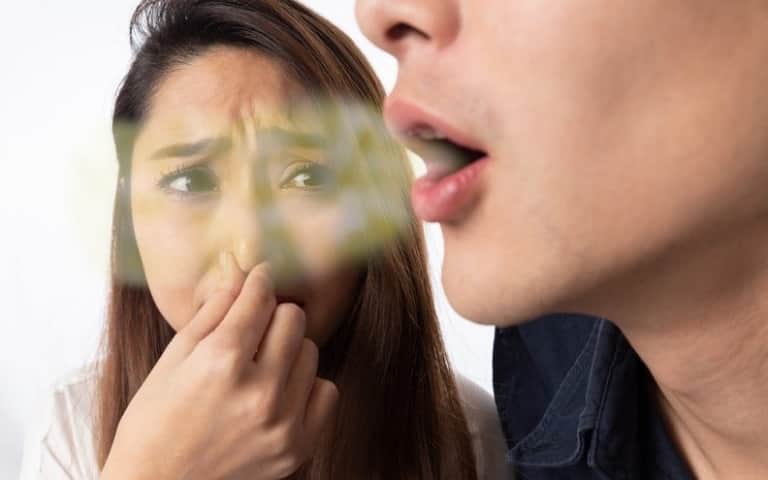Bad breath, medically known as halitosis, is characterized by an unpleasant odor of the mouth.
Halitosis can occur on occasion, or it can be a chronic condition.
Bad breath typically originates in the mouth, where bacteria are ever present.
When you eat, bits of food get caught in your teeth.
Bacteria grow on these bits of food, releasing foul-smelling sulfur compounds.
When the mouth is not brushed often, these bits of food clog causing bacteria to grow in the mouth, this leads to a thin film of bacteria known as plaque building up on the teeth.
When plaque isn’t brushed away at least twice per day, it produces a foul odor which leads to another smelly process, tooth decay.
All foods get stuck in the teeth, but certain foods like onions and garlic more commonly lead to bad breath.
Digestion of these foods release sulfur compounds into the bloodstream.
When the blood reaches the lungs, it affects the breath.
Other cause of bad breath include: dry mouth, dental problems, underlying health issues, oral infections and certain medications.
Skipping meals is a surefire way to have bad breath.
That is because when we don’t eat, we don’t produce as much saliva.
Saliva doesn’t just clean up food particles, it also breaks down that food to help it slide down the throats more easily.
Smoking not only increases the amount of odor-producing compounds in a person’s mouth and lungs, but the habit can also make the mouth dry, leading to lower saliva production.
People who slash their carbohydrate intake have been known to report increased levels of halitosis.
Symptoms of bad breath include: unpleasant odor or taste in the mouth, dry mouth or white coating on the tongue.
Not to worry, we have got some simple home remedies to help fight bad breath.
Oral hygiene
The first step to getting rid of bad breath is practicing good oral hygiene.
This can be achieved by brushing the mouth (teeth and tongue), twice daily with fluoride toothpaste to remove food debris and plaque.
Parsley
Parsley is a popular folk remedy for bad breath.
Its fresh scent and high Chlorophyll content suggest that it can have a deodorizing effect.
Chew parsley on fresh leaves after each meal to combat bad breath.
Water
A dry mouth is one of the causes of bad breath.
Saliva plays a very important role in keeping the mouth clean.
Without it, bacteria thrive.
The mouth dries out naturally during sleep, this is why breath is typically worse in the morning.
Dry mouth can be prevented by keeping the body hydrated.
Drinking water (not caffeinated or sugary drinks) throughout the day will help encourage saliva production.
Aiming for at least eight glasses of water per day is key to keeping oneself hydrated.
Pineapple juice
Many people believe that pineapple juice is the quickest and most effective treatment for bad breath.
While there is no scientific evidence to back up this theory, anecdotal reports suggest that it works.
Drinking a glass of organic pineapple juice after every meal, or chew on a pineapple slice for one to two minutes is key to getting rid of bad breath.
It is also important to remember to rinse the mouth of the sugars in fruit and fruit juice afterward.
Milk
Milk is a well-known cure for bad breath.
Research shows that drinking milk after eating garlic can significantly improve “garlicky” breath.
Drinking a glass of low- or full-fat milk during or after a meal containing strong-smelling foods like garlic and onions helps keep the mouth clean and free of bad breath.
Was this helpful? Share your thoughts with us.

 Join Daily Trust WhatsApp Community For Quick Access To News and Happenings Around You.
Join Daily Trust WhatsApp Community For Quick Access To News and Happenings Around You.



